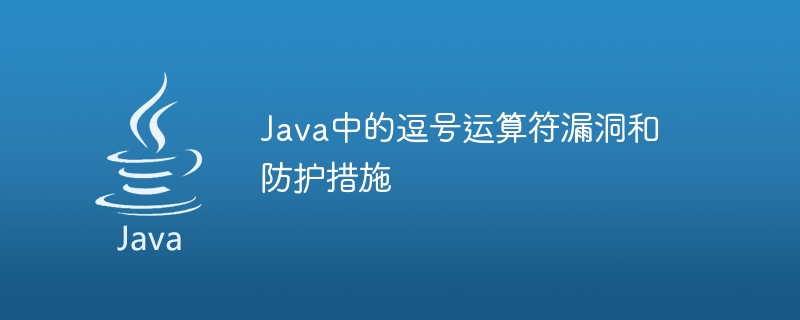Home >Java >javaTutorial >Comma operator vulnerabilities and protective measures in Java
Comma operator vulnerabilities and protective measures in Java
- WBOYWBOYWBOYWBOYWBOYWBOYWBOYWBOYWBOYWBOYWBOYWBOYWBOriginal
- 2023-08-10 14:21:061194browse

Comma operator vulnerabilities and protective measures in Java
Overview:
In Java programming, we often use the comma operator to perform multiple operations at the same time . However, sometimes we may overlook some potential vulnerabilities of the comma operator that may lead to unexpected results. This article will introduce the vulnerabilities of the comma operator in Java and provide corresponding protective measures.
Usage of comma operator:
The syntax of comma operator in Java is expr1, expr2, which can be said to be a sequence operator. What it does is calculate expr1 first, then ignore its result and calculate expr2, and finally return the result of expr2. The main application scenario of the comma operator is in for loops or method calls, where multiple operations can be performed in one statement.
Comma operator vulnerability:
The comma operator vulnerability is mainly manifested in the fact that we may ignore the result of expr1, which may cause unexpected errors in the program. Consider the following example:
int x = 5; int y = 10; int z = (x++, y++); System.out.println(z); // 输出10
In the above example, we use the comma operator to increment the value of x by 1 and ignore the result, then calculate the value of y and increment it by 1 and return it. Since the comma operator ignores the result of expr1, the final value of z is 10 instead of 6.
Protection measures:
In order to prevent the occurrence of comma operator vulnerabilities, we can take the following protection measures:
- Use brackets: where the comma operator needs to be used , add parentheses to the entire expression to clarify the order of calculation. For example:
int z = ((x++), (y++)); System.out.println(z); // 输出6
By bracketing the entire expression, you ensure that both x and y values are correctly incremented by 1, and the result of the last expression is returned.
- Try not to perform operations with side effects in the comma operator: In order to avoid confusion and programming errors, it is recommended not to perform operations with side effects in the comma operator, such as changing the value of a variable or calling a side effects method.
- Use code specifications and comments: Using clear naming and comments can reduce the occurrence of comma operator vulnerabilities to a certain extent. For example, add a comment prompt to the code block containing the comma operator to clarify the role and meaning of the comma operator.
Conclusion:
The comma operator is a commonly used sequence operator in Java that can perform multiple operations in one statement. However, we need to be careful about some potential vulnerabilities of the comma operator, which can lead to unexpected program errors. By using parentheses, avoiding operations with side effects, and using clear naming and comments, we can reduce the occurrence of comma operator vulnerabilities and improve the reliability and maintainability of our programs.
The above is an introduction to comma operator vulnerabilities and protective measures in Java. By understanding and using the comma operator correctly, we are better able to write robust Java code.
The above is the detailed content of Comma operator vulnerabilities and protective measures in Java. For more information, please follow other related articles on the PHP Chinese website!
Related articles
See more- Share an example of using SQL injection vulnerability to drag the library
- Do system vulnerabilities need to be fixed?
- Basic methods for dealing with operating system vulnerabilities
- ThinkPHP6 Arbitrary File Operation Vulnerability Analysis
- Some common security vulnerabilities and defense methods on PHP websites

